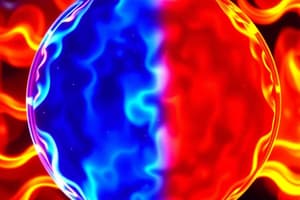Podcast
Questions and Answers
What is the term used to describe the process of a liquid turning into a gas?
What is the term used to describe the process of a liquid turning into a gas?
- Evaporation (correct)
- Sublimation
- Solidification
- Condensation
When does condensation occur?
When does condensation occur?
- When a gas loses energy and transitions to a liquid state (correct)
- When a solid gains energy and transitions to a liquid state
- When a liquid gains energy and transitions to a gaseous state
- When a solid loses energy and transitions to a gaseous state
What is the temperature at which water boils and transitions from a liquid to a gaseous state?
What is the temperature at which water boils and transitions from a liquid to a gaseous state?
- $50^\circ$C
- $75^\circ$C
- $100^\circ$C (correct)
- $0^\circ$C
What is the process called when a solid material transitions directly to a gaseous state without first becoming a liquid?
What is the process called when a solid material transitions directly to a gaseous state without first becoming a liquid?
How does the random motion of water molecules change during the boiling process?
How does the random motion of water molecules change during the boiling process?
What is the primary factor that determines whether evaporation or condensation occurs?
What is the primary factor that determines whether evaporation or condensation occurs?
What is the main difference between sublimation and evaporation?
What is the main difference between sublimation and evaporation?
What is the primary factor that determines the rate of sublimation?
What is the primary factor that determines the rate of sublimation?
How does the heat of vaporization of water compare to that of ethanol?
How does the heat of vaporization of water compare to that of ethanol?
What is the relationship between heat capacity and phase changes?
What is the relationship between heat capacity and phase changes?
Which of the following statements about dry ice is most accurate?
Which of the following statements about dry ice is most accurate?
How does the energy required for phase changes vary among different substances?
How does the energy required for phase changes vary among different substances?
Flashcards are hidden until you start studying
Study Notes
Heat energy plays a crucial role in our daily lives, from regulating room temperatures to processing food. Understanding how heat affects various forms of energy is essential for both scientific exploration and practical applications. In this article, we explore phase changes—specifically evaporation, condensation, and sublimation—which involve exchanging heat between solid, liquid, and gaseous materials.
Evaporation and Condensation
Evaporation and condensation are two common examples of phase changes. When a liquid turns into a gas, a process known as evaporation occurs. Conversely, when a gas becomes a liquid via heat loss, a process called condensation takes place. Both evaporation and condensation require energy input or output depending on the environment's temperature and pressure.
Consider boiling water as an example. Heating water increases the random motion of its molecules, which eventually allows them to escape into the atmosphere as water vapor. This increase in molecular energy causes a rise in temperature, making the water reach its boiling point. As the water reaches the boiling point, it transitions from the liquid state to the gaseous state.
Contrarily, if water droplets come into contact with a cooler surface, they lose energy due to heat transfer from the water to the surrounding area. This cooling effect reduces the water's random motion, causing some molecules to transition back from the gaseous to the liquid state through a process called condensation.
Sublimation
Sublimation is another form of phase change where a material moves directly from the solid state to the gaseous state without passing through the liquid stage. A popular example of sublimation is dry ice, which undergoes this phase change as it transforms from a solid to a mist of fine CO2 particles.
Unlike evaporation and condensation, sublimation requires less energy input. It primarily depends on the temperature and pressure conditions present in the environment. For instance, dry ice will sublime when exposed to air at standard atmospheric conditions because it is held at lower temperatures and pressures compared to water.
Energy Requirements for Phase Changes
In general, phase changes require either heat absorption (evaporation and sublimation) or heat release (condensation) by the associated material. The amount of energy required or released during these processes varies for each substance.
For example, consider the difference between water and ethanol. Water has a higher heat of vaporization (i.e., the energy required to convert liquid water to water vapor) compared to ethanol. Due to this, water requires more energy to evaporate at the same temperature and pressure conditions.
Moreover, different substances have varying heat capacities, reflecting the specific energy needed to raise the temperature of one unit mass of a substance by one degree Celsius while keeping the heat capacity constant. Thus, understanding the relationship between heat energy and phase changes helps us appreciate why certain materials exhibit unique properties such as high boiling points or low volatility.
In conclusion, heat energy significantly influences phase changes in materials, shaping the behavior of various substances around us. By studying these phenomena, scientists gain valuable insights into chemical reactions, industrial processes, and environmental interactions, ultimately paving the way for advancements in technology and sustainability efforts.
Studying That Suits You
Use AI to generate personalized quizzes and flashcards to suit your learning preferences.




